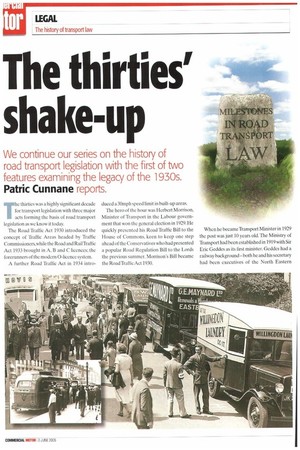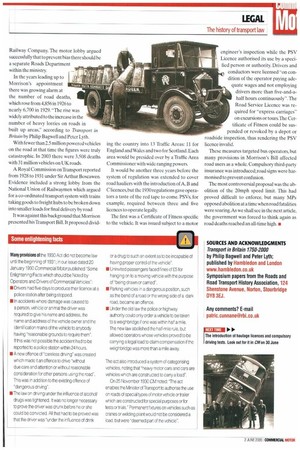The thirties' shake-up
Page 34

Page 35

If you've noticed an error in this article please click here to report it so we can fix it.
We continue our series on the history of road transport legislation with the first of two features examining the legacy of the 1930s.
Patric Cunnane reports.
he thirties was a highly significant decade Ifor transport legislation with three major acts forming the basis of road transport legislation as we know it today The Road Traffic Act 1930 introduced the concept of Traffic Areas headed by Traffic Commissioners, while the Road and RailTraffic Act 1933 brought in A, B and C licences; the forerunners of the modem 0-licence system.
A further Road Traffic Act in 1934 intro duced a 30mph speed limit in built-up areas.
The hero of the hour was Herbert Morrison, Minister of Transport in the Labour government that won the general election in 1929. He quickly presented his Road Traffic Bill to the House of Commons, keen to keep one step ahead of the Conservatives who had presented a popular Road Regulation Bill to the Lords the previous summer. Morrison's Bill became the Road Traffic Act 1930, When he became Transport Minister in 1929 the post was just 10 years old. The Ministry of Transport had been established in 1919 with Sir Eric Geddes as its first minister. Geddes had a railway background—both he and his secretary had been executives of the North Eastern Railway Company. The motor lobby argued successfully that to prevent bias there should be a separate Roads Department within the ministry.
In the years leading up to Morrison's appointment there was growing alarm at the number of road deaths, which rose from 4,856 in 1926 to nearly 6,700 in 1929. "The rise was widely attributed to the increase in the number of heavy lorries on roads in built up areas," according to Transport in Britain by Philip Bagwell and Peter Lyth.
With fewer than 2.5 million powered vehicles on the road at that time the figures were truly catastrophic. In 2003 there were 3,508 deaths with 31 million vehicles on UK roads.
A Royal Commission on Transport reported from 1928 to 1931 under Sir Arthur Boscawen. Evidence included a strong lobby from the National Union of Railwaymen which argued for a co-ordinated transport system with trains taking goods to freight hubs to be broken down into smaller loads for final delivery by road It was against this background that Morrison presented his Transport Bill. It proposed divid ing the country into 13 Traffic Areas: 11 for England and Wales and two for Scotland. Each area would be presided over by a Traffic Area Commissioner with wide ranging powers.
It would be another three years before the system of regulation was extended to cover road hauliers with the introduction of A, B and C licences, but the 1930 regulations gave operators a taste of the red tape to come. PSVs, for example, required between three and five licences to operate legally.
The first was a Certificate of Fitness specific to the vehicle. It was issued subject to a motor engineer's inspection while the PSV Licence authorised its use by a specified person or authority. Drivers and conductors were licensed "on condition of the operator paying ade quate wages and not employing drivers more than five-and-a half hours continuously". The Road Service Licence was re quired for "express carriages" on excursions or tours.The Certificate of Fitness could be suspended or revoked by a depot or roadside inspection, thus rendering the PSV licence invalid.
These measures targeted bus operators, but many provisions in Morrison's Bill affected road users as a whole. Compulsory third-party insurance was introduced; road signs were harmonised to prevent confusion.
The most controversial proposal was the abolition of the 20mph speed limit. This had proved difficult to enforce, but many MPs opposed abolition at a time when road fatalities were soaring. As we shall see in the next article, the government was forced to think again as road deaths reached an all-time high. •






































































































































































































